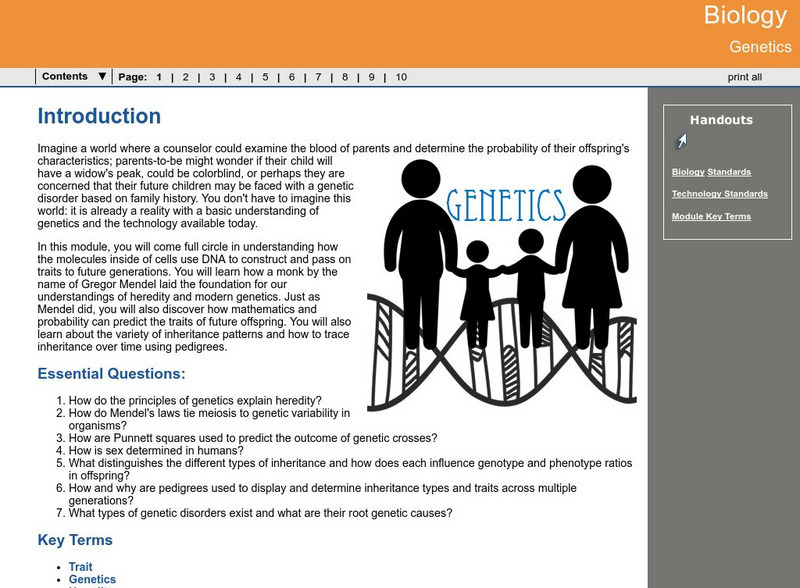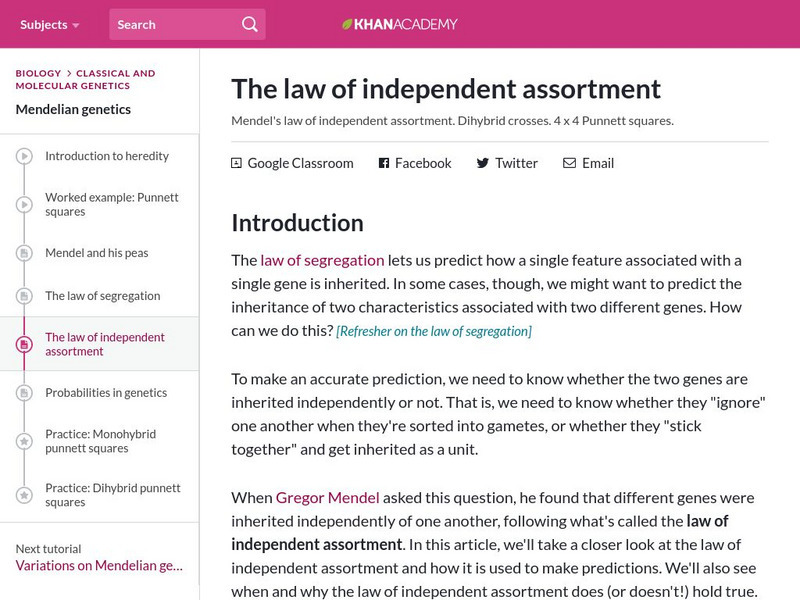Hi, what do you want to do?
Curated OER
Dragon Genetics Lab-Principles of Mendelian Genetics
Students study genetic traits using popsicle sticks as chromosomes. For this biology lesson, students explain how traits are inherited from parents. They differentiate dominant and recessive genes.
Curated OER
Genetics Mendelian
Students explore genetic terms, the Law of Dominance and the contributions of Gregor Mendel. After discussing Mendel's lab and his pea plants students observe examples of a phenotype chart. Afterward, they conduct their own lab to...
US National Library of Medicine
Basic Genetic Concepts and Terms
Have you ever wondered why you aren't taller or invisible? It all comes down to your dominant and recessive genes. Introduce your class members to genetics with a presentation that includes worksheets for young geneticists to...
Curated OER
Mendellian Genetics
Learners describe the inheritance patterns other than simple dominance. They are taught how Mendel's principles apply to all organisms. Students review the use of Punnett Squares. They are taught the principles of probability and...
Curated OER
Applying the Laws of Inheritance
Biology and mathematics can be integrated through a study of Mendelian Genetics.
Curated OER
Incomplete Dominance
In this biology worksheet, students use the information given about genetics and Sponge Bob to complete each section of the sheet. They identify and explain incomplete dominance and use it to help them complete the questions that follow.
Curated OER
What is Genetics?
In this biology worksheet, 9th graders name two forms of the trait for seed shape observed by Mendel. Then they determine the percentage of the possible types of offspring that have the same genotype as the parents. Students also explain...
Curated OER
Evolution
High schoolers investigate the concept of evolution and its implications upon the origin and development of life. They conduct research using a variety of resources while focusing upon cross-over and mutations. The information is used to...
Curated OER
Problem Solving in Genetic Disorders
A class of older and academically mature students are divided into pairs, usually one male and one female and are told that they are expecting a child. Unfortunately, their child may or may not have inherited some form of genetic...
Curated OER
Taster/Non-taster Lab Activity
Pupils determine if they are tasters or non-tasters and then replicate the experiment with family and peer group members. They collect data from the experiment to determine which trait is dominant.
Curated OER
Genetics the Easy Way
Young scholars use recyclable trash to construct a Recycle Critter family. They calculate the probability of the phenotype of the offspring that two heterozygous parents produced.
Curated OER
Using Blood Tests to Identify Babies and Criminals
Students solve a crime by matching a suspect's blood type to physical evidence collected at the crime scene. In this forensic science lesson, students identify the different blood types. They explain how blood tests work.
Curated OER
Multiple Alleles
Young scholars observe models of the ABO blood system including erythrocytes, antigens, and antibodies. They investigate the antigens that result from certain allele combinations and move antibodies to determine whether agglutination ...
CK-12 Foundation
Ck 12: Biology: Punnett Squares
[Free Registration/Login may be required to access all resource tools.] Describes how to use a Punnett square to predict genotypes and phenotypes.
CK-12 Foundation
Ck 12: Episd: Punnett Squares
[Free Registration/Login may be required to access all resource tools.] While building on the study of genetics, students will understand how to predict genetic traits with the application of Punnett Squares.
CK-12 Foundation
Ck 12: Biology: Punnett Squares
[Free Registration/Login may be required to access all resource tools.] Describes how to use a Punnett square to predict genotypes and phenotypes.
CK-12 Foundation
Ck 12: Life Science: Punnett Squares
[Free Registration/Login may be required to access all resource tools.] A Punnett square is a special tool derived from the laws of probability. It is used to predict the offspring from a cross, or mating between two parents. Learn more...
BioMan Biology
Bio Man Biology: Snurfle Meiosis and Genetics
Find out about the phases of meiosis in this learning module that has Snurfles reproducing. Explore the connection between genetics and meiosis, learn how to use Punnett squares, and all about chromosomes. Then try the quiz to check your...
Georgia Department of Education
Ga Virtual Learning: Biology: Genetics
Through informational text, interactive activities, practice problems, and video clips, students analyze how biological traits are passed on to successive generations.
ClassFlow
Class Flow: Punnett Squares
[Free Registration/Login Required] Students will use Punnett Squares to analyze how biological traits are passed on to successive generations.
CK-12 Foundation
Ck 12: Biology: Mendelian Inheritance Study Guide
Review the processes of basic Mendelian genetics.
Khan Academy
Khan Academy: The Law of Segregation
Resource provides a discussion of Mendel's law of segregation with a focus on genotype, phenotype, alleles, heterozygous/homozygous, and 2 x 2 Punnett squares.
Khan Academy
Khan Academy: The Law of Independent Assortment
Article defines Mendel's law of independent assortment, provides examples, and takes a look at how it is used to make predictions. Also, discusses dihybrid crosses and 4 x 4 Punnett squares.
Other
Clermont College: Genetic Practice Problems
Clermont College provides a good interactive practice test using Punnett squares.


























